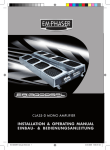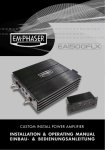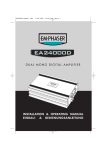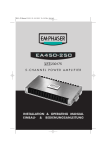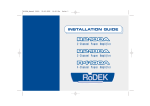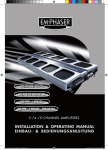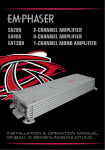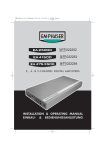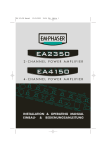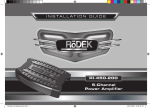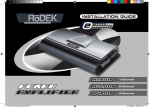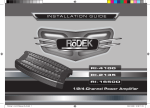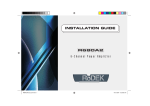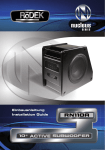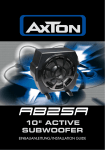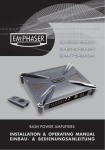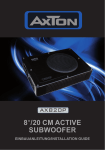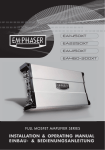Download EMPHASER EA1800D Specifications
Transcript
EA1350D EA11 35 EA 350D 50 0D 0D EA1800D EA11 80 EA 800D 00 00D 0D CLASS-D MONO AMPLIFIERS Installation & Operating Manual Einbau- & Bedienungsanleitung EA1350-1800D Manual (EDF).indd 1 28.02.2006 12:03:36 Uhr CONTENTS 1.DESIGN FEATURES 2. CONNECTIONS & CONTROLS 2.1 FRONT PANEL CONNECTIONS & CONTROLS Page 5 6-8 6-7 2.2REAR PANEL CONNECTIONS 8 2.3SPEAKER IMPEDANCE & POWER WIRE INFO 9 3.AMPLIFIER MOUNTING 9 4. WIRE ROUTING 10 4.1 MAIN POWER WIRES 10 4.2RCA & REMOTE WIRES 10 4.3 LOUDSPEAKER WIRES 10 4.4 MASTER/SLAVE CONNECTION SCHEMATIC 11 4.5 GenerAl CONNECTION SCHEMATIC 12 5. 13 CROSSOVER ADJUSTMENTS 5.1LOWPASS CROSSOVER FREQUENCY ADJUSTMENT 13 5.2SUBSONIC HIGHPASS CROSSOVER ADJUSTMENT 13 5.3 INPUT LEVEL ADJUSTMENT 13 5.4PHASE-SHIFT ADJUSTMENT 14 6.TECHNICAL SPECIFICATIONS 27-28 7.LIMITED WARRANTY 30 7.1 WARRANTY LIMITATIONS 30 8. 31 WARRANTY CARD EA1350-1800D Manual (EDF).indd 2 28.02.2006 12:03:36 Uhr INHALT 1.TECHNISCHER AUFBAU / MERKMALE Seite 17 2.ANSCHLÜSSE & BEDIENUNGSELEMENTE 18-20 2.1.EINGÄNGE & FUNKTIONEN AM FRONT PANEL 18-19 2.2EINGÄNGE AM REAR PANEL 20 2.3LAUTSPRECHER-IMPEDANZ & POWERKABEL INFO 21 3. MONTAGE DES VERSTÄRKERS 21 4. VERKABELUNG / ELEKTRISCHER ANSCHLUSS 22 4.1 HAUPT-STROMKABEL 22 4.2 CINCH- & REMOTE KABEL 22 4.3 LAUTSPRECHERKABEL 22 4.4 MASTER/SLAVE ANSCHLUSS-SCHEMA 23 4.5 GENERELLES ANSCHLUSS-SCHEMA 24 5.EINSTELLUNG DER FREQUENZWEICHE 24 5.1TIEFPASS TRENNFREQUENZ EINSTELLUNG 25 5.2SUBSONIC HOCHPASS TRENNFREQUENZ EINSTELLUNG 25 5.3ANPASSUNG DER EINGANGSEMPFINDLICHKEIT 25 5.4PHASE-SHIFT EINSTELLUNG 26 6.TECHNISCHE SPEZIFIKATIONEN 27-28 7.GARANTIE-BESTIMMUNGEN 30 7.1GARANTIE-EINSCHRÄNKUNGEN 30 8.GARANTIEKARTE 31 EA1350-1800D Manual (EDF).indd 3 28.02.2006 12:03:36 Uhr Congratulations! And thank you for choosing this EMPHASER EA1350D/EA1800D digital mono amplifier! To maximize the performance of this amplifier and your car audio system install, we recommend that you acquaint yourself thoroughly with all capabilities and features of this EMPHASER amplifier. Please read this manual carefully, before attempting the installation and retain this manual and your purchasing / installation receipts for future reference. IMPORTANT NOTICE: In case you are installing your EMPHASER amplifier by yourself, you should have your installation checked and approved by an authorized professional EMPHASER dealer/installer, in order to qualify for full warranty protection and also, to reach maximum power-output and audio performance possible with your individual car audio system. EA1350-1800D Manual (EDF).indd 4 28.02.2006 12:03:36 Uhr 1. DESIGN FEATURES ■ CAR AUDIO AMPLIFIER: This EMPHASER class-D amplifier allows the cross-over controlled amplification of subwoofer systems ■ DASH-MOUNT REMOTE LOWPASS LEVEL CONTROL: A compact „Lowpass-Level“ remote control unit can be mounted close to the drivers seat. This control device allows the convenient level adjustment of the bass volume. ■ DIGITAL AMPLIFICATION: This EMPHASER amplifier features an extremely efficient class-D circuitry layout, to guarantee excellent sonic performance and very high power output. ■ 4 / 2 / 1 OHM LOAD STABILITY: This EMPHASER amplifier works totally stable into impedance loads down to 1.0 ohms. The high damping factor guarantees full control over the connected subwoofer system. ■ INTEGRATED ELECTRONIC CROSSOVER: The internal crossover section features fully variable subsonic and lowpass filters with crossover slope rates of 12/24 dB/octave. ■ VARIABLE PHASE-SHIFT: This amplifier features a variable phase-shift control option, that allows to adjust the output signal from 0 to 180°. ■ MASTER – SLAVE CONFIGURATION: Two EA1350D/EA1800D can be connected together, to obtain an ultra high output power twin-amp configuration. ■ UNCOMPROMISING DESIGN AND CONSTRUCTION: Only best electrical and electronic components have been used for the assembly of this amplifier line. Such as double-sided glass-fiber epoxy circuit boards equipped with high current TR output devices. ■ ADVANCED PROTECTION CIRCUITRY: The protection circuitry safe-guards the amplifier from short-circuits at the speaker outputs, DC offset voltage at the outputs and overheating of power electronics. ■ STATUS AND PROTECTION LED’S: A green and a red LED located at input the side panel enable you to monitor the operating status of your EMPHASER amp. ■ ADJUSTABLE INPUT SENSITIVITY: Each RCA line-input pair accepts input voltages from 300mV to 7V, providing a good match with the line-output levels of almost any head-unit on the market. EA1350-1800D Manual (EDF).indd 5 28.02.2006 12:03:37 Uhr 2. CONNECTIONS & CONTROLS 2.1 FRONT P����������������� ANEL CONNECTIONS & �� CONTROLS �������� 01 POWER LED Green “operation” LED, signaling correct operation of the amplifier 02 INPUT GAIN CONTROL Input level gain control potentiometer, allowing to match the output voltage of the headunit’s RCA line-outs to the amplifier input section 03 RCA INPUTS 1/2-CH Low-level stereo RCA signal input for connection with line-out of the head-unit (sub-out) 04 SUBSONIC CROSSOVER FREQUENCY CONTROL Crossover control potentiometer for the frequency adjustment of the 12dB/oct. subsonic high-pass filter 05 LOW PASS CROSSOVER FREQUENCY CONTROL Crossover control potentiometer for the frequency adjustment of the 24dB/oct. low-pass filter 06 PHASE SHIFT CONTROL Phase control potentiometer for the relative phase adjustment of the subwoofer(s) connected to the amplifier output terminals 07 RCA For Master/Slave Operation RCA output to connect another EA1350D/EA1800D class-D amplifier 8 SWITCH FOR MASTER/SLAVE OPERATION Telephone jack input socket for connection with the dash-mounted low-pass level remote unit 9 REMOTE LOW PASS LEVEL PORT Slide switch to define each amp being either master or slave 10 PROTECTION LED Red “protection” LED, signaling faulty speaker connections or general malfunction of the amplifier EA1350-1800D Manual (EDF).indd 6 28.02.2006 12:03:37 Uhr REAR PANEL EA1350D 1 2 3 4 3 5 6 78 9 bl REAR PANEL EA1800D 1 2 3 4 3 5 6 78 9 bl EA1350-1800D Manual (EDF).indd 7 28.02.2006 12:03:39 Uhr 2.3 Speaker Impedance & POWER WIRE INFO The heat dissipation capacity of this amplifier has been designed to cope with very low impedance loads. However, EMPHASER laboratories recommend to stay at or above the suggested impedance ratings listed below: EA1350D/EA1800D ➡ 1 ohms mono 2 x EA1350D/EA1800D in Master/Slave configuration ➡ 2 ohms mono Note: EMPHASER laboratories recommend a minimum main power cable cross-section (5m total length) of minimum 35mm² better 50 mm², when the amp is intended to be operated at full output power for prolonged periods of time. These recommendations guarantee trouble-free operation of your amplifier, giving you full power output. 3. Amplifier Mounting Attention! For your own safety, disconnect the positive battery terminal (+12V) or remove the main fuse in the positive power cable near the car battery, before you start any wiring work! Before you proceed to install this EMPHASER amplifier, it is recommended to map out the complete audio system and the respective wiring required. Consider all additional electrical requirements and accessories, such as power cables, interconnect cables etc., to complete this install. Please note that - because of possible interference problems with the existing car electrics and electronics - especially the routing of the signal cables and the chassis ground connection will have a profound impact on the trouble-free (noise free!) operation of the amplifier. The mounting location should be carefully selected and in the interest of passive driver and passenger safety, the amplifier must be securely mounted. Make sure that there is no wiring harness, fuel tank etc. behind or below the mounting surface, that may be damaged by the drilling of the holes for the amplifier mounting screws. After installation, there should be a clearance of at least 5cm to all sides including the top of the amplifier heatsink. Make sure the unit is not exposed to direct sunlight, humidity, water, oil or spill of other fluids that may enter the amplifier. Once the location where the amplifier will be mounted is defined, use the unit as a template for the marking of the mounting holes with pencil or felt-tip marker. The mounting holes should be pilot-drilled, using a 2,5mm or 3mm drill bit. For the actual mounting, always use the supplied rubber washers before attaching the amp to the panel with the supplied mounting screws. Important! There must not be a direct contact of the amplifier heatsink, bottom panel or other metal parts to the vehicle chassis ground! Electrical ground-loops can result in audible hum! EA1350-1800D Manual (EDF).indd 9 28.02.2006 12:03:41 Uhr 4. WIRE ROUTING 4.1 Main Power WIRES Run the positive main power cable („+12 V“) directly from the positive terminal of the car battery to the amplifier. For protection of your car audio system against electrical fire hazards, resulting from a short-circuit of the main power cable to chassis ground a main fuse holder must be inserted within the first 30 cm of the positive main power cable. The applicable fuse value must be matched to the limitations of your main power cable AND the current draw of the amplifier – therefore choose an appropriate fuse value. Attach the ground cable to the amplifier. In most cases it will be best to keep the ground cable („-12V“) as short as possible, i.e. to find a chassis contact very close to the amplifier. The ground power wire must have the same cross-section as the positive power cable. The contact point where the ground wire is attached to, must be solid and clean, i.e. free from rust or paint! Tighten both power input terminals of the amplifier, and double check for perfect fit of both main cable leads! 4.2 RCA & REMOTE WIRES Carefully run the audio signal interconnects, the amp remote wire and – if applicable - the cable of the low pass level remote control from the head-unit or dashboard to the amplifier. As mentioned before, the audio signal cables should always be routed completely separate from the power cables. Connect the remote (turn on/turn off) lead to the respective input terminal of the amplifier and to the remote output of your head-unit. Now you can connect the RCA interconnects to the respective outputs of your head-unit and to the inputs of the amplifier. The remote low pass level remote control unit can be mounted in any convenient position where it can be reached while you drive in your car. 4.3 Loudspeaker WireS Once the speaker cables have been routed, turn loose the screws of the speaker terminal binding posts and – after inserting the stripped speaker cables – re-tighten the screws. When baring wires for connection, remove approximately 6-8mm of the insulation and after axially twisting the wires, insert the bare ends into the corresponding speaker terminal output on the amplifier. Close the electrical circuit by inserting the main fuse. Now switch on your head unit. The green OPERATING LED of the amplifier should light up. If the LED lights up red, your installation is wrong! Immediately turn off your head-unit and carefully re-check all installation steps! 10 EA1350-1800D Manual (EDF).indd 10 28.02.2006 12:03:41 Uhr 4.5 GENERAL CONNECTION SCHEMATIC 12 EA1350-1800D Manual (EDF).indd 12 28.02.2006 12:03:45 Uhr 5. CROSSOVER ADJUSTMENTS 5.1 LOWPASS CROSSOVER FREQUENCY ADJUSTMENT Note: Before you attempt to adjust the lowpass crossover frequency, you must set the subsonic highpass filter to its lowest position (10 Hz). The LOWPASS cut-off frequency setting depends on some variables. As a rule of thumb, settings in a range between 60 to 90 Hz will render best sonic results. If you use this amp for SPL scores, it is advisable to set the lowpass crossover frequency above 80Hz. Note: In general, setting the lowpass cross-over frequency too low, will result in a weak and muddy sounding bass, while setting this crossover frequency too high will result in a ‘booming’ bass sound and reduced low end extension. 5.2 SUBSONIC HIGHPASS CROSSOVER FREQUENCY ADJUSTMENT Adjust the SUBSONIC potentiometer according to your needs. This setting depends on the dimension and the power handling of the installed subwoofer system. The higher the subsonic crossover frequency is set, the higher the mechanical power handling of the connected subwoofer system will be. The trade-off is reduced low end extension! The subsonic highpass can not be bypassed! But you can set the SUBSONIC control to its lowest position at 10 Hz, which will not longer impose an audible effect on the music played. 5.3 INPUT LEVEL ADJUSTMENT To reach a maximum in dynamic response from each individual head-unit/amplifier/speaker combination, it is important to set the respective input level controls („GAIN“) of this amplifier correctly. Before you start, you MUST set all tone controls (Bass, Mid, Treble, Loudness etc.) and the fader on the head unit to their neutral or center positions. Now turn all input gain controls of the installed amplifiers anti-clockwise to their minimum positions and start with the EA1350D/EA1800D, that drives the subwoofer system! The low pass level remote control – if installed in your system configuration - should be set at a low position, so there is enough headroom to turn up the bass volume later on. Set the volume control of your head-unit to approximately ¾ of full volume, while playing a dynamic piece of music. Slowly increase the input gain control of the channel pair, that drives the subwoofer(s), by turning the GAIN control clockwise until you can just about hear distorted sounds coming out of your subwoofer system. Reduce the main volume level on your head-unit to a medium listening level. 13 EA1350-1800D Manual (EDF).indd 13 28.02.2006 12:03:45 Uhr 5.4 PHASE-SHIFT ADJUSTMENT The phase shift function of the EA1350D/EA1800D can not be deactivated, as it is permanently in the signal chain. The phase-shift control enables you to match the acoustical phase relations of subwoofer and the speaker system playing in the front doors. The target is, that both speaker systems, normally separated by aprox. 3m of distance shall play acoustically “in-phase” at the drivers seat location. A good match of the acoustical phase between subwoofer and the system in the front doors will give you the impression of bass sounds coming from a place in front of you. Or the other way round, the subwoofer playing in the trunk of your car can not be localized that easily. The second advantage is, that the upper bass region – i.e. where the sound waves radiated by the subwoofer and the kickbass or front door mounted component system are crossing over - will sound considerably more precise and tight. This phase adjustment can only be determined by ear, so you will need somebody to help you to obtain best phase match. To judge the effect of the phase-shift adjustment, you must sit on the drivers seat, and somebody must adjust the phase shift control knob until the sound reproduction in the bass region is best. Furthermore, it might be necessary to invert the (connection) polarity of your subwoofer – and re-adjust the phase, if you can not find a proper match with the normal in-phase subwoofer connection. Note: When two EA1350D/EA1800D amplifiers are run in Master-Slave configuration, only the phase-shift control of the amp in MASTER mode will be active. The amp that runs in Slave mode has its control functions deactivated – ALL settings must be done on the Master amp. 14 EA1350-1800D Manual (EDF).indd 14 28.02.2006 12:03:45 Uhr 15 EA1350-1800D Manual (EDF).indd 15 28.02.2006 12:03:46 Uhr Herzlichen Glückwunsch! Wir danken Ihnen, dass Sie sich zum Kauf dieses ����������������������������������������� EA1350D/EA1800D�������������������������� Verstärkers von EMPHASER entschieden haben. Damit Sie die Wiedergabequalität und die Leistungsfähigkeit Ihres Verstärkers voll ausschöpfen können, möchten wir Sie bitten, sich eingehend mit den Möglichkeiten und technischen Features dieses Verstärkers vertraut zu machen. Lesen Sie deshalb die nachfolgenden Abschnitte sorgfältig durch und bewahren Sie diese Bedienungsanleitung für allfällige, vielleicht später auftauchende Fragen auf. WICHTIGE INFO: Wenn Sie den Einbau dieses Car-HiFi Verstärkers selbst vornehmen, lassen Sie Ihren Einbau abschliessend von Ihrem Händler auf fachgerechte Installation überprüfen. Damit sichern Sie sich die volle Garantieleistung und stellen weiterhin sicher, dass Ihre Car-HiFi Anlage ihre volle Klangqualität und Leistungsfähigkeit erreicht. 16 EA1350-1800D Manual (EDF).indd 16 28.02.2006 12:03:46 Uhr 1. TECHNISCHER AUFBAU/MERKMALE ■ CAR AUDIO Verstärker: Dieser Verstärker dient zum Antrieb von Hochleistungs-Subwoofer Systemen. ■ Subwooferpegelregelung über externe Kabelfernbedienung: Die im Fond des Fahrzeuges montierbare kleine Fernbedienung ermöglicht die bequeme Anpassung der Lautstärke des Subwoofers vom Fahrersitz aus. ■ DIGITAL VERSTÄRKER: Eine Class-D Verstärkerschaltung sorgt für enorm hohe Ausgangsleistungen mit sehr hohem Wirkungsgrad. ■ 4 / 2 / 1 Ohm Stabilität: Der Mono-Kanal dieses Verstärkers kann Lastimpedanzen von 4 Ohm bis hinunter auf 1 Ohm optimal antreiben. Das Layout der Ausgangstufe ist ausserdem auf niedrigen Innenwiderstand getrimmt, der Verstärker hat durch den resultierenden hohen Dämpfungsfaktor den oder die angeschlossenen Subwoofer voll „im Griff“. ■ Integrierte elektronische Frequenzweiche: In diesem Verstärker sind ein Tiefpassund ein Subsonicfilter mit einer Flankensteilheit von 12/24 dB/Okt. integriert. ■ IntegrierteR PHASE-SHIFT: Dieser Verstärker verfügt über einen elektronischen Phase-Shift, der es ermöglicht die Phase des Ausgangssignals von 0 bis 180° einzustellen. ■ MASTER – SLAVE BETRIEB: Zwei EA1350D/EA1800D Verstärker können mit einem Cinchkabel zu einer Master-Slave Einheit zusammengeschlossen werden. ■ Kompromissloser AuFbau und Konstruktion: Durch die ausschliessliche Verwendung von hochwertigsten Materialien in der Fertigung, ist die Betriebssicherheit besonders hoch. Zum Einsatz kommen z.B. doppelseitig kaschierte Epoxy Glasfaser-Epoxydharzplatinen, hochstromfähige Transistoren etc. ■ Intelligente Schutzschaltung: Die integrierte Schutzschaltung erkennt Kurzschlüsse an den Lautsprecherausgängen, Gleichspannung im Ausgangssignal und überhöhte Betriebstemperatur. Fehlerhafte Betriebszustände führen zum sofortigen Abschalten des Gerätes. ■ POWER / Protect LED’s: Am Side Panel auf der Cinch-Eingangsseite befinden sich zwei LED’s, welche den Betriebs-Status des Verstärkers anzeigen. ■ Grosser Regelbereich der Eingangsempfindlichkeit: Die Line Level Eingangspaare akzeptieren Vorverstärker-Signale von 300mV bis 7V. Dies garantiert, dass diese Endstufe mit allen am Markt erhältlichen Steuergeräten kombiniert werden kann. 17 EA1350-1800D Manual (EDF).indd 17 28.02.2006 12:03:46 Uhr 2. ANSCHLÜSSE & BEDIENUNGSELEMENTE 2.1. EINGÄNGE & FUNKTIONEN AM FRONT PANEL 1POWER LED Grüne „Power“ LED, signalisiert den normalen Betriebszustand der Endstufe im eingeschalteten Zustand 2 REGLER EINGANGSEMPFINDLICHKEIT Eingangsempfindlichkeits-Poti, für die Anpassung an die Ausgangsspannung des Steuergerätes 3 CINCH INPUTS 1/2-CH Cinch Eingangsbuchsen 1/2-CH für den Anschluss der Cinch Ausgänge (Sub-Out) des Steuergerätes 4 REGLER SUBSONIC TRENNFREQUENZ Regelpoti zum Einstellen der Subsonic Hochpass-Trennfrequenz an der integrierten elektronischen Frequenzweiche 5 REGLER TIEFPASS TRENNFREQUENZ Regelpoti zum Einstellen der Tiefpass-Trennfrequenz an der integrierten elektronischen Frequenzweiche 6PHASEN REGLER Regelpoti zum Einstellen der Phase des Ausgangs-Signals 7 CINCH-BUCHSE MASTER/SLAVE Ausgangsbuchse/Eingangsbuchse, zum Verbinden von zwei EA1350D/EA1800D, die im Master/Slave Betrieb konfiguriert und betrieben werden sollen 8 SCHALTER FÜR MASTER / SLAVE BETRIEB Schiebeschalter für die Festelegung der Arbeitsweise der Endstufe, als Master- oder als Slave Amp. Wenn die Endstufe als Einzelverstärker verwendet wird, muss dieser Schiebeschalter auf Master stehen 9EINGANGSBUCHSE FÜR DIE FERNBEDIENUNGSEINHEIT Telefonbuchsen Eingang, zum Anschluss der Verbindungskabels der Fernbedienungseinheit für die Pegelregelung 10PROTECTION LED Rote „Protection“ LED, signalisiert eine generelle Fehlfunktion der Endstufe, wie z.B. Kurzschluss an den Lautsprecherausgängen, Überhitzung sowie Gleichspannung an den LS-Ausgängen 18 EA1350-1800D Manual (EDF).indd 18 28.02.2006 12:03:46 Uhr REAR PANEL EA1350D 1 2 3 4 3 5 6 78 9 bl REAR PANEL EA1800D 1 2 3 4 3 5 6 78 9 bl 19 EA1350-1800D Manual (EDF).indd 19 28.02.2006 12:03:48 Uhr 2.3 LAUTSPRECHER IMPEDANZ & POWERKABEL INFO Die Wärmekapazität der Kühlrippen dieser Endstufe wurde bei dieser Verstärker-Serie für niederohmige Lasten ausgelegt. Die minimale Abschlussimpedanz der EA1350D/EA1800D steht unten und darf nicht unterschritten werden! Beachten Sie nachfolgende Empfehlungen: EA1350D/EA1800D ➡ 1 Ohm mono EA1350D/EA1800D x 2 ➡ 2 Ohm mono (Master-Slave Betrieb) ➡ HAUPTSTROMKABEL EMPHASER empfiehlt einen minimalen Kabelquerschnitt (bei einer Länge von 5m) von mindestens 35 mm² für das +12V und das Massekabel. Falls die Endstufe an sehr niederohmigen Lasten oder gar zwei EA1350D/EA1800D im Master-Slave Betrieb arbeiten müssen, sollte die Verwendung von 50 mm² Haupt- und Masse Stromkabeln selbstverständlich sein. Diese Empfehlungen garantieren eine problemlose Funktion dieses Verstärkers, sowie die volle Leistungsabgabe ohne übermässige Erwärmung. ➡ CINCHKABEL Für besten Klang und hohe Einstörfestigkeit sollten nur beste Cinchkabel verwendet werden. Verwenden Sie dreifach abgeschirmte Kabel, oder aber sogenannte „Twisted Pair“ Typen. Beachten Sie, dass speziell die Musiksignalführenden (Cinch-) Kabel soweit als möglich von allen potentiellen „elektrischen Störsendern“ wie Bordcomputer, Benzinpumpe, Black Boxes, etc. verlegt werden. ➡ LAUTSPERCHER KABEL Verwenden Sie qualitativ gutes Lautsprecherkabel mit einem minimalen Querschnitt von 2.5mm². Kabelquerschnitte bis 4.0mm² können durchaus Sinn machen. 3. MonTAge des Verstärkers ACHTUNG! Entfernen Sie zu Ihrer eigenen Sicherheit erst das Pluskabel vom Pluspol der Batterie! Bei allen nachfolgend beschriebenen Installationsschritten muss der Stromkreis des Kraftfahrzeugs unterbrochen sein! Erst nach Abschluss aller Installationsarbeiten wird über das Pluskabel der Stromkreis wieder geschlossen. Bevor Sie mit der Montage dieses Verstärkers beginnen: Berücksichtigen Sie vorab die Kabelverläufe und den Installationsort des Car-Amps. Der Verstärker sollte im Interesse der Sicherheit bei einem Unfall möglichst gut und solide montiert werden. Die Endstufe sollte auf keinen Fall „unzugänglich verbaut“ werden, wegen der schlechten Kühlung und auch den abschliessend erfolgenden Einstellarbeiten an den Side-Panels. Als Montageort eignet sich z.B. ein Platz im Kofferraum oder an einem Seitenteil, bzw jeder andere Ort, der eine saubere Installation ermöglicht. Vermeiden Sie Montageorte mit „unbekanntem Hintergrund“. Es könnten sich ein Benzintank, hydraulische Bremsleitungen, Kabelbäume etc. dahinter verbergen! Achten Sie auch auf einen trocken, gegen mechanische Einwirkungen geschützten Installationsort. 21 EA1350-1800D Manual (EDF).indd 21 28.02.2006 12:03:50 Uhr 4. Verkabelung/Elektrischer Anschluss Halten Sie den Verstärker an den gewünschten Ort und markieren Sie mit einem geeigneten Filzstift die Bohrposition der Befestigungslöcher. Mit der gebotenen Vorsicht bohren Sie nun die angezeichneten Löcher mit einem 2,5 oder 3 mm Bohrer. ACHTUNG: Die Endstufe darf niemals direkt auf die Fahrzeugmasse des Kfz’s geschraubt werden! Verwenden Sie die beigelegten Gummi-Isolatoren um die Endstufe(n) von der Fahrzeugmasse isoliert zu montieren. Legen Sie nun den Verstärker auf die vorgebohrten Löcher und schrauben Sie ihn gut fest. 4.1 HAUPT-STROMKABEL Verlegen Sie nun das Pluskabel direkt von der Batterie zum Verstärker. Innerhalb der ersten 30 cm nach dem Pluspolklemmenabgriff muss eine Hauptsicherung angebracht werden (Absicherung des Pluskabels gegen Kurzschluss auf Fahrzeug-Masse und dadurch resultierendem Kabelbrand!) Verwenden Sie eine dem Stromkabelquerschnitt entsprechende Haupt-Sicherung. Schliessen Sie nun das Minuskabel am Verstärker an und an eine Massepunkt im Fahrzeug an. Versuchen Sie dieses Kabel so kurz wie möglich zu halten. Es sollte ausserdem den selben Querschnitt wie das Pluskabel besitzen. Achten Sie beim Massepunkt auf eine perfekt gesäuberte blanke Metalloberfläche im Fahrzeug (schlechte Massepunkte sind für über 90 % aller Fälle der auftretenden Störungen verantwortlich). 4.2 CINCH- & REMOTE KABEL Verlegen Sie das oder die Cinchkabel, das Fernbedienungskabel für die Pegel-Regelung von den Kanälen die den Subwoofer treiben und das Remote-Kabel vom Steuergerät zur Endstufe. Diese Kabel sollten unbedingt räumlich getrennt von der Stromzuführung des Verstärkers eingezogen werden. Schliessen Sie das Remote-Kabel an das mit „REM“ bezeichnete Terminal an der Endstufe und an das mit Antenna-Rem. oder Amplifier-Rem. bezeichnete Kabel Ihres Steuergerätes an. Anschliessend stecken Sie die Cinchkabel in die Cincheingangsbuchsen am Verstärker ein. Nun wird noch die Fernbedienung in Griffnähe angebracht und die Stecker des Kabels in die Buchsen am Verstärker und an der Fernbedienung eingesteckt. Die Pegelregelung des Kanal-Paares im Lowpass Betrieb - mittels kabelgebundener Fernbedienungseinheit - ist optional. 4.3 LAUTSPRECHERKABEL Schliessen Sie nun die Lautsprecher Kabel an. Entfernen Sie ca. 6-8 mm der Isolierung des LS-Kabels und beachten Sie die richtige Polung der Lautsprecherkabel am Terminal (Plus auf Plus, Minus auf Minus). Ziehen Sie die LS-Schraublemmen satt an. Schliessen Sie nun den Stromkreis zum Verstärker durch das Einsetzen der Hauptsicherung. Ihr Verstärker sollte nun beim Einschalten des Steuergerätes durch das Aufleuchten der grünen Power-LED die Betriebsbereitschaft anzeigen. Leuchtet die Protection-LED rot auf, ist Ihre Installation fehlerhaft. Gehen Sie die gesamten Installationsanweisungen nochmals genau durch. 22 EA1350-1800D Manual (EDF).indd 22 28.02.2006 12:03:50 Uhr 4.5 GENERELLES ANSCHLUSS-SCHEMA 24 EA1350-1800D Manual (EDF).indd 24 28.02.2006 12:03:53 Uhr 5. EINSTELLUNG DER FREQUENZWEICHE 5.1 TIEFPASS TRENNFREQUENZ ACHTUNG! Drehen Sie das „SUBSONIC“ Potentiometer auf 10 Hz – bevor Sie sich an die Einstellung des Tiefpassreglers machen. Die zu wählende Trennfrequenz des Tiefpasses (LPF) beim Betrieb eines Subwoofers sollte ungefähr im Bereich zwischen 60 bis 90 Hz liegen. Falls die Endstufe für SPL Einsatz verwendet werden soll, darf die Tiefpassfrequenz nicht unter 80 Hz eingestellt werden. Justieren Sie den „LPF“ Regler so, dass der Bass satt und trocken mit genügend Tiefbassanteil wiedergegeben wird. Diese Einstellung erfolgt rein gehörmässig. Eine zu tiefe Trennfrequenz lässt den Bassbereich kraftlos und unkonturiert wirken. Eine zu hohe Trennfrequenz bewirkt ein Dröhnen des Bassbereichs. 5.2 SUBSONIC HOCHPASS TRENNFREQUENZ Um den angeschlossenen Subwoofer von unnötiger Hubarbeit im subsonischen Bereich zu schützen, verfügt diese Endstufe über einen immer im Signalweg liegenden Subsonic-Hochpass (d.h. er lässt sich nicht ausschalten!). Das Subsonicfilter lässt sich aber auf 10Hz herunterregeln und hat bei einer so tief liegenden Einsatzfrequenz keinen hörbaren Einfluss auf die Basswiedergabe mehr. Das „Subsonicfilter“ schneidet alle Frequenzen unter dem eingestellten Wert mit 12dB/Okt. ab und filtert so die sehr tiefen (unhörbaren) Frequenzanteile im Programm-Material heraus, die das angeschlossene Subwoofersystem entweder nicht wiedergeben kann, oder die bei hohen Ausgangspegeln zu extremen Membran-Auslenkungen führen können. Die Subsonic-Trennfrequenz ist je nach Belastbarkeit des angeschlossenen Subwoofer-Systems recht unterschiedlich und sollte daher gründlich erprobt werden. 5.3 Anpassung der Eingangsempfindlichkeit Die korrekte Eingangsempfindlichkeitseinstellung ist wichtig für die Ausnutzung des optimalen Dynamikspielraumes Ihrer Steuergerät/Verstärker/ Lautsprecherkombination. Diese Empfindlichkeitseinstellung beeinflusst das Grundrauschen ebenso wie die verzerrungsfrei erzielbare Maximallautstärke. ACHTUNG! Bevor Sie mit der Anpassung der Eingangsempfindlichkeiten anfangen müssen zuallererst alle Klangregler, sowie auch der Fader/Balance in die Mittel (Neutral) Position gebracht werden. Die Loudnessfunktion ist auch zu deaktivieren. Drehen Sie den Input GAIN Regler an der EA1350D/EA1800D im Gegenuhrzeigersinn auf die Minimumposition. Zuerst wird immer der Pegelabgleich des Kanalpaares am Verstärker vorgenommen, welches das Subwoofersystem antreibt! Stellen Sie den Lautstärkeregler Ihres Steuergerätes auf ca. ¾ der Maximallautstärke und benutzen Sie für die nun kommende Einstellung ein gut aufgenommenes dynamikreiches Musikstück. Drehen Sie nun den GAIN Regler von der EA1350D/EA1800D langsam (Achtung! langsam!) im Uhrzeigersinn auf, bis Sie gerade die Verzerrungsgrenze im Bassbereich erreichen. Dann drehen Sie den GAIN Regler gerade soweit zurück, dass die Verzerrungen wieder verschwinden. Die Einstellung der Basspegel-Fernbedienung sollte für die oben beschriebene Einstellung der Eingangs-Empfindlichkeit etwa in der Mittelstellung sein. Hierdurch ist sichergestellt, dass später genügend Reserven für die Bassregelung vorhanden sind! 25 EA1350-1800D Manual (EDF).indd 25 28.02.2006 12:03:53 Uhr 5.4 EINSTELLUNG VOM PHASE-SHIFT Der Phase-Shift Regler ermöglicht die Beeinflussung der Phasenlage des angeschlossenen Subwoofer Systems. Mit diesem Regler – und gegebenenfalls durch zusätzliches Umpolen des Subwoofers, ist es möglich eine perfekte akustische Phaselage zwischen dem Subwoofer und dem Frontsystem (oder auch den Kickbässen, wenn vorhanden) zu erzielen. Wenn die Einstellung „passt“, ist der Subwoofer nicht mehr im Kofferraum des Fahrzeuges ortbar, und die subjektive Sauberkeit der Wiedergabe des oberen Bassbereiches nimmt zu. Die Anpassung der Phasenlage des Subwoofers lässt sich nur mit der Hilfe einer zweiten Person bewerkstelligen. Der hörbare Effekt, wenn der Phase-Shift Regler verstellt wird, muss auf dem Fahrersitz beurteilt werden. Wem diese Einstellung zu schwierig ist, kann auch nur mittels umpolen des Subwoofers die generell richtigere Anschlussvariante austesten. In so einem Fall wird dann der Phase-Shift einfach in seiner linksanschlag (0°) Stellung belassen. Wenn zwei Endstufen im Master-Slave Betrieb zusammengekoppelt werden, sind nur die Bedienelemente vom MASTER Amp aktiv! Am Verstärker der im Slave Betrieb läuft, lässt sich nichts einstellen!!!! ACHTUNG: Wenn zwei oder mehrere EA1350D/EA1800D Endstufen in einem Systemkonzept zum Einsatz kommen – diese aber NICHT im Master-Slave Betrieb verwendet werden – müssen die Phase-Shift Regler von ALLEN EA1350D/EA1800D’s entweder auf links oder rechtsanschlag stehen. Ansonsten ergibt sich durch einen Phasenversatz eventuell eine Auslöschung der Basssignale!!!! 26 EA1350-1800D Manual (EDF).indd 26 28.02.2006 12:03:53 Uhr 6. TECHNISCHE SPEZIFIKATIONEN EA1350D CLASS-D MONO VERSTÄRKER 520W x 1 @ 4 Ohm (< 1.0% THD / 14.4V) 850W x 1 @ 2 Ohm (< 1.0% THD / 14.4V) 1200W x 1 @ 1 Ohm (< 1.0% THD / 14.4V) 1 Ohm stabil Full-MOS-FET Class-D Verstärker Master / Slave Betrieb möglich Variables Subsonicfilter, 10 – 60Hz mit 12dB/Okt. Variables Tiefpassfilter, 30 – 300Hz mit 24dB/Okt. Variabler Phase-Shift von 0 – 180° Variable Eingangsempfindlichkeit von 0.3 – 7V Dämpfungsfaktor an 4 Ohm: > 350 Signal-Rauschabstand: > 85dB Externe Basspegel-Fernbedienung 25mm² Strom-Anschluss Terminals Dimensionen BxHxT: 350 x 62 x 250mm 6. Technical Specifications EA1350D CLASS-D MONO AMPLIFIER 520W x 1 @ 4 ohms (< 1.0% THD / 14.4V) 850W x 1 @ 2 ohms (< 1.0% THD / 14.4V) 1200W x 1 @ 1 ohms (< 1.0% THD / 14.4V) 1 ohms stable Full MOS-FET class-D amplification circuitry Master / slave operation Variable subsonic highpass filter, 10 – 60Hz with 12dB/oct. Variable lowpass filter, 30 – 300Hz with 24dB/oct. Fully variable phase-shift 0 – 180° Variable input sensitivity: 0.3 – 7V Damping factor @ 4 ohms: > 350 Signal to noise ratio: > 85dB Remote low pass level remote control 25mm² direct power input terminals Dimensions WxHxD: 350 x 62 x 250mm 27 EA1350-1800D Manual (EDF).indd 27 28.02.2006 12:03:53 Uhr 6. TECHNISCHE SPEZIFIKATIONEN EA1800D CLASS-D MONO VERSTÄRKER 870W x 1 @ 4 Ohm (< 1.0% THD / 14.4V) 1600W x 1 @ 2 Ohm (< 1.0% THD / 14.4V) 2200W x 1 @ 1 Ohm (< 1.0% THD / 14.4V) 1 Ohm stabil Full-MOS-FET Class-D Verstärker Master / Slave Betrieb möglich Variables Subsonicfilter, 10 – 60Hz mit 12dB/Okt. Variables Tiefpassfilter, 30 – 300Hz mit 24dB/Okt. Variabler Phase-Shift von 0 – 180° Variable Eingangs-Empfindlichkeit von 0.3 – 7V Dämpfungsfaktor an 4 Ohm: > 350 Signal-Rauschabstand: > 85dB Externe Basspegel-Fernbedienung 50mm² Strom-Anschluss Terminals Dimensionen BxHxT: 540 x 62 x 250mm 6. Technical Specifications EA1800D CLASS-D MONO AMPLIFIER 870W x 1 @ 4 ohms (< 1.0% THD / 14.4V) 1600W x 1 @ 2 ohms (< 1.0% THD / 14.4V) 2200W x 1 @ 1 ohms (< 1.0% THD / 14.4V) 1 ohms stable Full MOS-FET class-D amplification circuitry Master / slave operation Variable subsonic highpass filter, 10 – 60Hz with 12dB/oct. Variable lowpass filter, 30 – 300Hz with 24dB/oct. Fully variable phase-shift 0 – 180° Variable input sensitivity: 0.3 – 7V Damping factor @ 4 ohms: > 350 Signal to noise ratio: > 85dB Remote low pass level remote control 50mm² direct power input terminals Dimensions WxHxD: 540 x 62 x 250mm 28 EA1350-1800D Manual (EDF).indd 28 28.02.2006 12:03:53 Uhr 29 EA1350-1800D Manual (EDF).indd 29 28.02.2006 12:03:54 Uhr 7. Limited Warranty Dear customer Please read the warranty specifications below carefully. Should your EMPHASER product require warranty service, please return it to the retailer from whom it was purchased or the distributor in your country. Please do not send any product to EMPHASER Inc. U.S.A. Should you have difficulty in finding an authorized EMPHASER service center, details are available from your local distributor. This EMPHASER amplifier is fully warranted against defective materials or workmanship for a period of two years from date of purchase at retail. Warranty work will not be carried out unless this warranty certificate is presented fully completed with serial number, purchaser’s address, purchasing date and dealer stamp together with the original sales slip and either an authorized dealer’s confirmation of installation or authorized dealer’s installation approval! 7.1 Warranty Limitations This warranty does not cover any damage due to: 1. Unauthorized or unapproved installation, incorrect audio or mains connection(s). 2. Exposure to excessive humidity, fluids, sun rays or excessive dirt or dust. 3. Accidents or abuse, unauthorized repair attempts and modifications not explicitly authorized by the manufacturer. This warranty is limited to the repair or the replacement of the defective product at the manufacturer’s option and does not include any other form of damage, whether incidental, consequential or otherwise. The warranty does not cover any transport costs or damages caused by transport or shipment of the product. 7. Garantie-Bestimmungen Sehr geehrter Kunde, sehr geehrte Kundin Wir bitten Sie, die Originalverpackung für einen allfälligen Transport aufzuheben und die untenstehenden Garantie-Bestimmungen genau durchzulesen. Sollten Sie für Ihren Verstärker Garantie-Leistungen beanspruchen, wenden Sie sich bitte direkt an den Händler, bei dem Sie das Gerät gekauft haben. Bitte senden Sie keine Geräte an EMPHASER Inc. U.S.A. Bei Schwierigkeiten, ein geeignetes EMPHASER Service-Center zu finden, erhalten Sie bei Ihrem jeweiligen Landes-Vertrieb weitere Informationen. Der Hersteller gewährleistet auf diesen EMPHASER Verstärker für den Fall von Material- oder Herstellungsfehlern zwei Jahre Garantie, ab Kaufdatum in Fachhandel. Garantie-Ansprüche können nur mit einer korrekt und vollständig ausgefüllten Garantie-Karte zusammen mit dem OriginalKaufbeleg geltend gemacht werden. 7.1 Garantie-Einschränkungen Nicht unter Garantie fallen Schäden infolge von: 1. nicht-autorisierter bzw. nicht vom autorisierten Händler/Installateur geprüftem Selbst-Einbau oder inkorrekten Audio- oder Stromanschlüssen. 2. schädlichen Einwirkungen von übermässiger Feuchtigkeit, Flüssigkeiten, Hitze, Sonneneinstrahlung oder übermässiger Verschmutzung. 3. mechanischer Beschädigung durch Unfall, Fall oder Stoss; Schäden durch nicht autorisierte Reparaturversuche oder nicht durch den Hersteller ausdrücklich autorisierte Modifikationen. Die Garantie dieses Produkts bleibt in jedem Fall auf die Reparatur bzw. den Ersatz (Entscheidung beim Hersteller) des jeweiligen EMPHASER Produkts beschränkt. Schäden durch unsachgemässe Verpackung und daraus resultierende Transportschäden werden nicht durch diese Garantie gedeckt. Jeder über diese Garantie-Erklärung hinausgehende Anspruch und jede Haftung für direkte oder indirekte Folgeschäden werden ausdrücklich abgelehnt. 30 EA1350-1800D Manual (EDF).indd 30 28.02.2006 12:03:54 Uhr 8. WARRANTY CARD/GARANTIEKARTE 24 Months Limited Warranty: y) ation Approval onl d Install (Valid with authorize Model name: Class-D Mono Amplifiers ❏ EA1350D ❏ EA1800D Date of purchase: Serial number: Your name: Your address: City: State: ZIP or Postal Code: Country: Your phone number: Installation Approval Dealer’s address & stamp ❏ Installed by authorized dealer ❏ Self-installed by customer Installation date: Inspected and approved by: EMPHASER Inc., Wyoming, Michigan, U.S.A. Exclusive distributor for Europe & Asia ACR, Brändli & Vögeli AG, Bohrturmweg 1, CH-5330 Zurzach, Switzerland Phone: (+41) (0)56 269 64 64, Fax: (+41) (0)56 269 64 65, [email protected], www.acr.ch 31 EA1350-1800D Manual (EDF).indd 31 28.02.2006 12:03:54 Uhr EA1350D EA11 35 EA 350D 50 0D 0D EA1800D EA11 80 EA 800D 00 00D 0D Emphaser Inc., Wyoming, Michigan, U.S.A. EA1350-1800D Manual (EDF).indd 32 02.03.2006 19:36:11 Uhr
This document in other languages
- Deutsch: EMPHASER EA1800D
































